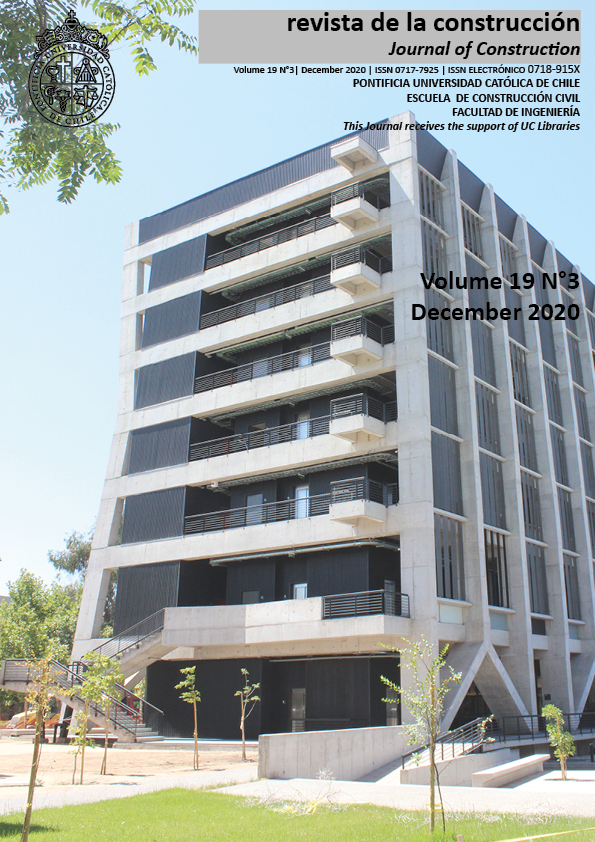Numerical analysis of an elastomeric bearing pad by hyperelastic models
DOI:
https://doi.org/10.7764/rdlc.19.3.301-310Keywords:
elastomeric bearing pad, bridges, deformation, hyperelastic model, finite elements analysisAbstract
Elastomeric bearing pads are responsible for transferring loads at the junction between beams and columns of bridges and viaducts, providing restrict freedom of movement in the superstructure. The elastomeric material of the bearing pad is a synthetic rubber reinforced with carbon black particles and subjected to a process of vulcanization, also represented by hyperelastic material models based on strain energy density functions. The objective of the present paper is to use the finite element analysis software Abaqus® to select the most appropriate hyperelastic model, as well as its constants, applying them in a bearing pad installed in an existing viaduct, evaluating its behavior and displacements resulting from the application of usual loads. The proposed methodology presents results coherent with technical specifications limits for available bearing pads products.
References
Arruda, E. M., & Boyce, M. C. (1993). A three-dimensional constitutive model for the large stretch behavior of rubber elastic materials. Journal of Mechanics and Physics of Solids, 389-412.
ASTM. (2016). American society for testing and materials D412. Standard Test Methods for Vulcanized Rubber and Thermoplastic Elastomers – Tension. West Conshohocken,: ASTM International.
Berselli, G., Vertechy, R, R., & Pellicciari, M, M. (2011). Hyperelastic modeling of rubber-like photopolymers for additive manufacturing processes, in Rapid Prototyping Technology – Principles and Functional Requirements, Hoque, M. (Ed.), IntechOpen.
Crisfield, M. A. (2000). Non-linear finite element analysis of solids and structures – Volume 2: Advanced topics. Chichester: John Wiley & Sons.
EN. (2005). European standart EN 1337. Structural bearings – Part 3: Elastomeric bearings. Bucharest.
Gajewski, M., Szczerba, R., & Jemiolo, S. (2015). Modelling of elastomeric bearings with application of Yeoh hyperelastic material model. Procedia Engineering 111, 220-227.
Gent, A. N. (2012). Engineering with rubber: how to design rubber components. 3nd ed. Alan N. Gent - Ohio, USA. Ohio, USA.: Alan N. Gent.
Huang, W., Xu, X., Wang, K., & Liu, W. (2018). Numerical Simulation of Steel-Laminated Bearing Considering Friction Slipping. International Journal of Engineering and Technology, 162-166.
Huang, W., Xu, X., Wang, T., Wang, K., & Liu, W. (2019). Study on Mechanical Property of Bridge Bearings under Eccentric Compression and Shearing. International Journal of Structural and Civil Engineering Research, 265-269.
Islam, A. M. (2017). Evaluation of story response in seismic prone building construction using high damping rubber bearing. Revista de la Construcción RDLC, 354-363.
Kalfas, K. N., Mitoulis, S. A., & Katakalos, k. (2016). Numerical study on the response of steel-laminated elastomeric bearings subjected to variable axial loads and development of local tensile stresses. Engineering Structures, 346-357.
Lalo, D. F., Greco, M., & Meroniuc, M. (2018). Numerical modeling and experimental characterization of carbon-black filled rubber models under viscoelastic effects through bulge test implementation for biaxial training. Mathematical Problems in Engineering, 14 pages.
Marlow, R. S. (2003). A General First-Invariant Hyperelastic Constitutive Model. Constitutive Models for Rubber III, 157-160.
Miller, K. (2004). Testing Elastomers for Hyperelastic Material Models in Finite Element Analysis. Testing and Analysis. Axel Products.
Mooney, M. (1940). A theory of large elastic deformation. Journal of Applied Physics, 582-592.
Ogden, R. W. (1972). Large deformation isotropic elasticity. On the correlation of theory and experiment for incompressible rubber-like solids. Philosophical Transactions of the Royal Society of London – Series A, 565-584.
Ogden, R. W. (1984). Non-Linear Elastic Deformations. Chichester: Harwood Series Mathematics and its Applications.
Shuijiang, W. (2018). Numerical calculation of bridge seismic response considering beam-block collision effect. Revista de la Construcción RDLC, 111-122.
Simulia. (2013). Abaqus analysis user's manual. Version 6.13 - Dassault Systems.
Stanton, J. F., & Roeder, C. W. (1982). NCHRP Report 248: Elastomeric Bearings Design, Construction, and Materials. Washington DC: Transportation Research Board.
Tavares, J. M. (1998). Introdução ao método dos Elementos Finitos. Porto / Portugal: FEUP.
Treloar, L. R. (1943). The elasticity of a network of long-chain molecules I. Transactions of the Faraday Society, 36-41.
Treloar, L. R. (1943). The elasticity of a network of long-chain molecules II. Transactions of the Faraday Society, 241-246.
Treloar, L. R. (1975). The Physics of Rubber Elasticity. London: Oxford University Press.
Valanis, K. C., & Landel, R. F. (1967). Strain-energy function of a hyper-elastic material in terms of the extension ratios. Journal of Applied Physics, 2997-3002.
Yeoh, O. H. (1993). Some forms of the strain energy function for rubber. Rubber Chemistry and Technology, 754-771.





